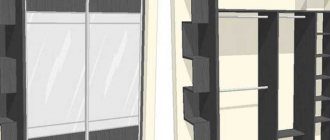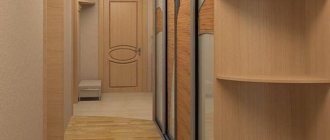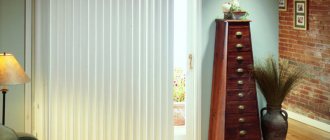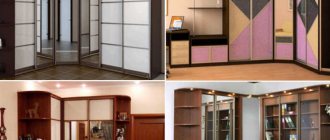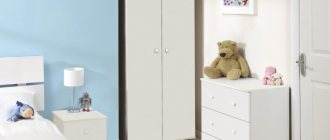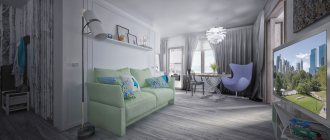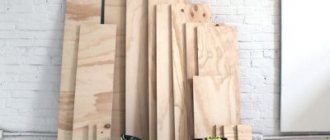86709
Due to the dynamic development of the furniture industry, new original mechanical devices for wardrobes and clothing have appeared that create comfort in human life. One of the subject trends for filling the interior space of furniture and maintaining order has become a retractable trouser drawer for the closet, which reduces the user’s effort during operation.
Longitudinal rods for clothing
The familiar and familiar clothes hanger in the form of a round or oval pipe can even be backlit. When choosing, you should pay attention to the strength of the fastening to the sides of the wardrobe.
If the niche for hangers is more than 60-70 cm in length, then it is better to opt for a chrome-plated round pipe with a diameter of 25 mm (Joker system). Thanks to the presence of various stops and holders, you can make an additional stop for the longitudinal bar so that it does not sag from the weight of outerwear placed on hangers. And also make a two-level storage system for short and long clothes.
- The advantage of rods fixed along the length of the wardrobe is obvious: the hangers hanging on it are turned sideways and you can immediately see where the clothes are hanging.
- The only drawback is that hangers for a wardrobe of this type require an appropriate depth, about 50-65 cm. And they are not suitable for shallow boxes (for example, in narrow hallways).
Dimensions
The universal design has furniture standards. To securely and safely hold things, a load of 15 to 20 kg is recommended. If the internal width of the cabinet is from 30 to 80 cm, it is allowed to use a module with tubes from 4 to 7 pcs. Typically frames with a number of rods are produced:
- length from 250 – 600 mm;
- metal thickness from 0.8 – 1.2 mm.
The movement of the trouser back and forth is carried out by four thin metal profiles and plastic rollers. All structural parts are highly resistant to corrosion and abrasion in any mounting location in the cabinet, ensuring smooth and silent movement.
Cross pull-out hanger for wardrobe
A clothes hanger with a transverse (perpendicular to sliding door) fastening is designed for narrow closets. Has many configurations:
- With fastening to the back of the shelf and the side of the cabinet.
- Be stationary, equipped with a retractable or folding mechanism.
- Externally it takes the form of a “loop”, “rake” and “fan”.
- Equipped with an elevator and other types of transformation.
Cross hangers for sliding wardrobes are used not only for hangers. They are convenient for hanging bags, belts, scarves and other clothing accessories. Can be supplemented with hooks, holders, stops and clamps for convenience.
They have one drawback - the relative fragility of the structure and the tendency to abrasion in places of increased friction during extension.
Types of storage systems
From a design point of view, a trouser rack is a longitudinal or transverse row of parallel holders.
Depending on the location of the device inside the closet or dressing room, there are:
- One-way side fastening. The trouser holder is attached to one wall of the closet: right or left, and the opposite edge remains free.
The most reliable method of fastening is fastening to two side walls, but it is also the most cumbersome, as it occupies the entire width of the opening. One-sided side structures are more compact, usually located under the central rod, but their “endurance” is also lower - such a holder will tilt under the weight of a large amount of clothing.
Trouser fasteners:
- Roller guides: consist of two parts, and extension is carried out by plastic rollers interspersed in characteristic grooves.
- Ball (telescopic) guides: consist of three moving elements. The extension occurs due to several rows of balls held in cells alternating in grooves.
Different materials are used for structures:
- tree,
- ABC and PVC plastic,
- stainless steel,
- anodized aluminum.
Metal products are the most reliable. They are coated with anti-corrosion compounds, and with chrome plating or silicone inserts, the surface is textured, which prevents clothing from slipping.
Plastic models are cheaper than others, but are subject to distortion under significant load.
Lift rod (pantograph)
The elevator mechanism can be equipped with both transverse and longitudinal bars for hangers. Such a hanger is usually placed right under the ceiling (the roof of the closet), and, if necessary, is lowered using a special handle. Usually about 170 cm in height are left under the pantograph so that the longest outerwear does not wrinkle.
- One of the advantages of using pantographs is the ability to make the most efficient use of the internal space of the wardrobe. But be careful when planning corner and U-shaped configurations: the pantograph needs to go down somewhere, so the space in front of it must be free and sufficient.
- The disadvantage is that the mechanism wears out relatively quickly, especially if the pantograph is used to place heavy outerwear (fur coats, sheepskin coats, winter jackets).
Choosing a pantsuit: tips
The following recommendations will help you invest your money profitably and not regret your purchase:
- The main sign of a comfortable pantsuit is that it matches the size of the wardrobe or closet.
- Some models are sold without frames and guides included; they will have to be purchased separately.
- Combined systems have additional compartments for storing accessories (ties, belts). For example, a retractable clothes holder from the Swedish company Pelly.
- The reason for refusing to purchase may be defects: a bent frame or uneven crossbars, nicks on the holders.
Lifehacks for long-term convenient use:
- If the edge of the holders is open, you can install silicone rings. They will not allow clothes to slip off.
- To securely hold things, a load of 15 to 20 kg is recommended.
- When installing, take into account the quality of the cabinet walls. If they are made of chipboard less than 2.5 cm thick, secure fixation is ensured using dowels for self-tapping screws.
- Suitable for storing not only trousers, but also skirts, scarves, and towels.
Pants or "skirts"
Trouser hangers with special crossbars parallel to each other are commonly called trouser hangers. However, it is convenient to hang not only trousers on them, but also skirts, as well as any other clothes that need to be stored in a suspended state. Thanks to special clips or the very configuration of the hanging compartments, wardrobe items are securely fixed and do not slip off.
Pants are most often equipped with a retractable mechanism. They can have a frame structure built into a cabinet niche with fastening to the sides, similar to a drawer. And also attached to one side of the partition or to the back of the shelf.
- The advantage is obvious - things do not wrinkle on such trouser hangers, and no additional hangers are required.
- Among the disadvantages, it is worth highlighting the bulkiness of the trouser design itself. It takes up extra space in the closet, and things don’t hang on it as tightly as on a rod.
Reviews
At first glance, a closet element such as a trouser drawer may seem optional, but in practice it becomes indispensable, and it becomes simply impossible to refuse such a storage system.
Owners of retractable storage systems for trousers note the convenience of this design and say there are no disadvantages. The trouser rack has handles on the sides, which make it easy to pull it out and push it back into the closet. The movement of the structure occurs almost silently due to smoothly sliding guides. The system is very reliable and can support a large number of pairs of trousers, but this, of course, depends on the type of trouser.
The trousers do not wrinkle when stored this way, and there are no creases from bending through the bars of the bar. For voluminous models of trousers, you can move the bars apart, thereby changing the distance between them.
Experienced housewives advise attaching trouser racks at a distance of at least 60 cm from the bottom shelf of the closet, this way the floors of the product will not become wrinkled and will not collect dust. You should not be afraid that trousers made of light fabric will slip off the bars - the bars have a corrugated surface and are additionally equipped with tucks. This system helps to save space in the closet, maintain order and ensures a quick search for the right thing.
You will learn more about retractable pants in the following video.
Due to the dynamic development of the furniture industry, new original mechanical devices for wardrobes and clothing have appeared that create comfort in human life. One of the subject trends for filling the interior space of furniture and maintaining order has become a retractable trouser drawer for the closet, which reduces the user’s effort during operation.
Brackets for scarves, ties and belts
Not only clothes, but also other wardrobe items can be stored hanging. Special brackets and hangers can be attached independently or offered as an additional accessory to another hanger for a sliding wardrobe - a longitudinal rod.
Hangers for a vacuum cleaner and iron are also on sale - they will allow you to organize a “utility corner” inside a dedicated compartment of a closet or dressing room.
Video
A trouser rack is not considered a necessary element of a home storage system. However, it makes life easier for its owners by preserving the ironed creases on dress trousers and optimizing closet space. There are stationary and retractable models. The latter are especially relevant as they provide easy and quick access to clothes. Let's look at the types of retractable trouser pants, their sizes, and give advice on choosing a model and making them yourself.
Shoe hanger
Some people are more accustomed to storing shoes in boxes, others select drawers or add mesh shelves to the wardrobe. In addition to these options, it is also possible to store shoes in a suspended state so that the tops of the boots do not wrinkle - using special hangers-holders.
As a rule, when developing the internal filling of a sliding wardrobe, several types of hangers are used. Many manufacturers offer a basic set of rods and hooks, trying to maximize the useful space of the cabinet when planning, combining it with shelves and drawers.

